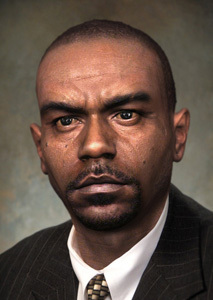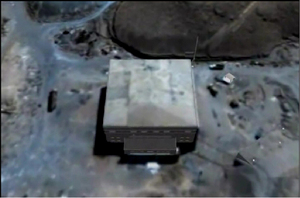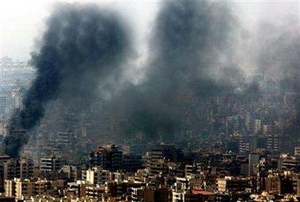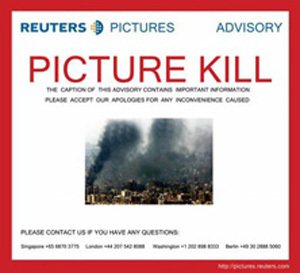Now imagine for a moment that a certain number of photographs in the media - let's say half, for the sake of this experiment - are forgeries. Would you be compelled to re-evaluate that position if you had learned said photograph was false?
In this world we inhabit, we rely largely on our visual perception as the weight and measure of the reality around us, and the powers that be utilize this fact to manipulate and distort what we perceive as reality.
In the past, propaganda was spread mainly by newspapers and periodicals in the form of the printed word. Yet as we have made so-called progress into the 21st century, literacy rates and the quality of education have fallen to the point that few people in "developed" nations read anymore. Thus, victims of the modern pathocratic system are left with one major source of what is perceived to be reliable information - visual media.
This reliance, when married with the transition to digital technologies, lays the foundation for mass deception on a scale greater than ever before. The pictures we see do, in fact, create a supposed reality in our minds of what occurs in far off places. The question in this digital age is whether those pictures are true representations, have been tampered with, or have been generated entirely from scratch.
With that in mind, take a look at these two job postings sourced from the websites of MI-6 and the CIA respectively:
ARTWORKERConsidering the historical precedent for the reality of "false-flag" operations, the fairly laughable notion of journalistic integrity and the history of various intelligence agencies' involvement with and control over major media outlets, do we really suppose that there are not at least a number of falsified photos that have been presented in major media as reliable photographic evidence?
"In many ways, this is an artworking job like any other. But you'll have the satisfaction of knowing that the ultimate purpose of everything you do is to protect the UK. You'll also benefit from very high-quality training in your specialist skills.
We're sure you'll understand that as an organisation that collects secret intelligence, we can't tell you a great deal about what you'll be doing. However, we can tell you you'll use the skills you've developed to produce computer generated artwork for print, web and media. You'll also have the chance to rapidly develop your knowledge of pre-press and printing techniques in a fascinating work environment, within our friendly Design and Print team.
Articulate, customer-focused and helpful, you'll be the ideal addition - particularly if you've worked in a Mac-based environment using Adobe CS and Quark XPress."
GRAPHIC DESIGNER
"Graphic Designers provide traditional printing, Web and multimedia support to the CIA's intelligence efforts. They use the latest technology to provide high-quality products utilized by policymakers throughout the federal government, including the President of the United States.
Graphic Designers also support Agency customers with hard- and soft-copy products, including Web sites, and they are responsible for a wide range of routine-to-complex projects such as: Web design, publications, brochures, cover design, posters, briefings, illustration, logos and exhibits. Opportunities exist to participate in internal training as well as external workshops and conferences."
As one example, consider this article written by a popular Canadian Blog:
"Set aside for a moment the journalistic misrepresentation on display in using a photo depicting air pollution to illustrate a story on the costs of meeting Kyoto mandated C02 reductions..Why indeed? It could be attributed to a shady journalism - a desire to beef up the story. One may think "sure, there's a few photos floating around that have been tampered with, it's not that harmful in the grand scheme of things." However, one may not realize the extent to which this is possible, or the more ominous purposes it may serve.

©CBC
There's a little more than lack of scientific accuracy going on here. Reader "JRB" wrote, wondering if there was evidence of photoshopping.
My initial reaction was "no". But then I noticed the file name (top-kyoto2.jpg) ends in the numeral "2". Now, I know what it means when I add a "2" to a file name, so I removed it to see if anything came up.

©CBC
How about that? It's an uncropped version of the same photograph, the difference in overall hue impossible to miss. A little extra searching reveals that CBC used the blue-toned image in a similar formats here and here.
So, with two dramatically different versions before me, the evidence that one has been altered is clear. Therefore, I think it's fair to ask - who at CBC news made the decision to "dirt enhance" the image that accompanies the item on John Baird's report?
And why?"
Have a look at this image:

|
| ©Sebcesoir |
This is not a photograph but was created by a contributor to the website HighEnd3D.com, and is 100% digitally generated.
A quick perusal of the linked website and a web search will illustrate the numerous visual possibilities inherent in creating photorealistic digital imagery. However, consider also the psychological possibilities. As evidenced by history, one image can easily trigger a mass reaction and draw people into a groupthink mentality. One could even say it creates a reality.
As the war drums tempo increases and the world slips further into chaos and dissent, it's not a stretch to imagine why media outlets or intelligence agencies would not only alter photographs, but create them from scratch. As we saw at the outset of the invasions of Afghanistan and Iraq, spectacular "evidence" is presented to the public in the media to bolster support for subsequent military actions.
Recently, concerning another incident of this spectacular "evidence," there's been an interesting development at the University of Minnesota.
The LA Times blog Babylon & Beyond writes in "SYRIA: More questions about alleged nuclear site"
Professor William Beeman at the University of Minnesota passed along a note today from "a colleague with a U.S. security clearance" about the mysterious Syrian site targeted in a Sept. 6 Israeli air strike.Even the least graphically-experienced reader can see the faults in this image. Remember that it was the Professor's source "with a U.S. security clearance" who pointed out that the image was altered.
The note raises more questions about the evidence shown last week by U.S. intelligence officials to lawmakers in the House and Senate.
The author of the note pinpoints irregularities about the photographs. Beeman's source alleges that the CIA "enhanced" some of the images. For example he cites this image:

©L.A. Times
The lower part of the building, the annex, and the windows pointing south appear much sharper than the rest of the photo, suggesting that they were digitally improved.
Is it that the really good examples of photo manipulations are never leaked - perhaps because they're not noticed - or is it that the really bad examples are leaked on purpose?
In 2006, one of these "bad examples" was released by Reuters, displaying heavy smoke rising from Beirut, Lebanon. The smoke had been "cloned" using Photoshop to increase the sense of destruction.

|
| ©Reuters |
Following exposure of the altered image, Reuters retracted the photo and admitted its error:

|
| ©Reuters |
Yet, one has to wonder - with the immense destruction that was rained down on Beirut, why the need to release a doctored image? Perhaps in the aftermath, the fickle opinion of the public is swayed to believe that the destruction was "not that bad." Well, the public need not worry, Reuters won't bother them with pictures of dead children.
Perhaps, as with with the image of the Syrian "nuclear site," these images are released to the public for the express purpose of sowing confusion, and/or a sense that the public has caught the media "in the act," and that they, the public, now know how to catch these discrepancies.
However, the street magician who seeks to amaze people with displays of prowess and skill also seeks to distract his audience from the true operation of the trick. The magician's goal is to ensure that the audience does not understand the trick, and ultimately accept the outcome and the magician's superior ability. On the other hand, perhaps by having part of the trick "revealed," the audience can be convinced that they have caught it, that they know what is going on.
In much the same way, psychopaths in positions of power employ sleight of hand - pathocratic prestidigitation. They utilize the mechanisms of the systems at their disposal to reinforce their authority and ultimately hypnotize the public - creating a reality in which the public believes what they have seen - or believes they know what they have seen. Yet they have not seen the true deception behind the trick.
Dr. Hany Farid of Dartmouth College is a researcher of image manipulation techniques. He and his team develop software that distinguish altered images from originals and trace the path of the alterations. In the introduction to his interview with journalist Ron Steinman, Steinman writes:
"As the interview makes clear, manipulation and doctoring of photos has a long history. Yet digital, with new tools that seem to increase daily, allows those without journalistic ethics, and those who have something to sell, whether politics, sex, celebrity, stocks or what have you, to alter individual images and sets of images for his or her gain. Some photographers, editors, plain folk, politicians and propagandists feel they have the right to alter any image or set of images for personal, political and commercial gain, often depending on his or her point of view.Steinman makes a very good point, and it would seem to correlate with what Andrew Lobaczewski writes in "Political Ponerology: A Science on the Nature of Evil Adjusted for Political Purposes":
For these people, the original or "real" photo may not be good enough. The image they see needs work, they think, and they know exactly how to reorder reality. It is a growing problem and one that any of us who has an interest in photography and truth should be alert to and understand."
"In a civilization deficient in psychological cognition, hyperactive individuals driven by their internal doubts caused by a feelings of being different easily find a ready echo in other people's insufficiently developed consciousness. Such individuals dream of imposing their power and their different experiential manner upon their environment and their society. Unfortunately, in a psychologically ignorant society, their dreams have a good chance of becoming reality for them and a nightmare for others."Dr. Farid lends another perspective to this idea in his interview with Steinman:
"We may have the sense that photo manipulation is a byproduct of digital photography. The reality is, however, that photographs have been manipulated for nearly as long as photography has been around. The nearly iconic portrait of Abraham Lincoln (circa 1860), for example, is a composite of Lincoln's head and Senator John Calhoun's body. Famed Civil War photographer Mathew Brady routinely doctored photographs to create more compelling images. And, Stalin, Mao, Hitler, Mussolini, Castro, and many more each had photographs manipulated in an attempt to alter history. Although photo manipulation is not new, digital photography has certainly made it easier to manipulate photographs in ways that can be difficult to detect."For historical information on photo tampering, see the section of Farid's website entitled Photo Tampering Throughout History.
On the surface, some, or all of this may seem innocuous - in the grand scheme of things. What's the problem with a few altered magazine covers and historical portraits? Do any of us really care if Lincoln's picture does not display his real body? It's an interesting, but seemingly far from threatening piece of information.
For historical information on reality tampering, read Manufactured Threat - Al Qaeda Videotapes Digitally Doctored.
What is threatening however is the combination of the technological wizardy available to doctor images, to effectively create reality, combined with the reality of psychopaths in power. These individuals must, in the pursuance of their dreams, find other individuals who will assist them in achieving their goals, often if not always deceiving those people as to the true operation of the con in which they are participating. Lobaczewski in Political Ponerology writes:
"In the psychopath, a dream emerges like some Utopia of a "happy" world and a social system which does not reject them or force them to submit to laws and customs whose meaning is incomprehensible to them. They dream of a world in which their simple and radical way of experiencing and perceiving reality would dominate; where they would, of course, be assured safety and prosperity. In this Utopian dream, they imagine that those "others", different, but also more technically skillful than they are, should be put to work to achieve this goal for the psychopaths and others of their kin."In our modern world, it is not photographic bust-enhancement, body-replacement, tooth-whitening, darkening of skies, cloning of smoke clouds or the images of fake buildings that we must concern ourselves with, but rather the probability that the large majority of altered, doctored or entirely computer generated images are never exposed as forgeries, and succeed in the completion of their desired task of deception.
Therefore in the pursuance of objective thinking, we must develop a critical eye, and a critical faculty of judgment. We must not rely solely on one source of information. We must network, to help each other with research, to look critically and examine the source.
It is impossible for any one person to achieve an objective view of this reality on their own, and it is in succumbing to the influences of nefarious propaganda that we fall victim to mass hypnosis and may lose control, not only of our minds, but ultimately our lives.



Altering photos is indeed old news. Even Stalin used to do it to these of his opponents that he wanted to be completely "removed". Apart from deleting the files of their existance he also had them edited out of official or party photographs.
But what we fail to realize sometimes is that today this can be done with VIDEO also. There are many VERY sophisticated tools available even to an average freelancer nowadays, let alone an "organization" with unlimited resources whose purpose is disinformation on a global scale. Today the only limit is the imagination really! Anything can be recreated digitaly if the purpose justifies the means. We ought to be VERY sceptical with what they show us, as suggested in the article. The tools are there, and the phychopaths to misuse them also. We should realize that we cannot anymore draw conclusions by seeing pictures or video.
Our only real tools are research, critical thinking and networking for the smoke go away.